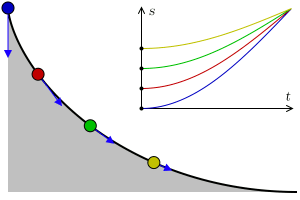등시강하곡선 문제 (Tautochrone problem)
개요
- 중력을 받고 있는 물체가 출발점에 관계없이 주어진 목적지에 똑같은 시간에 도달하기 위해서 따라야 하는 곡선
- 사이클로이드에 의하여 만족됨
- 1659년 호이겐스에 의해 해결
- 진자 시계를 만드는데 활용되었다 http://hom.wikidot.com/the-cycloid
등시성의 증명
(정리) 사이클로이드를 따라 움직이는 추의 주기는 시작점의 위치에 관계없이 다음으로 주어진다. \[T =2\pi\sqrt{\frac{r}{g}}\]
(이 때, 사이클로이드의 방정식은 \(x = r(\theta - \sin \theta)\), \(y = -r(1 - \cos \theta)\)로 주어졌다고 하자.)
(증명)
출발점의 y좌표를 \(y=y_0\)라 두고, 그 때 곡선의 파라메터를 \(\theta=\theta_0\)라 하자.
움직이는 추의 속도는 \(v=\sqrt{2g(y_0-y)}= \sqrt{2rg(\cos\theta_0-\cos\theta)}\) 로 주어진다. 따라서 주기를 다음과 같이 쓸 수 있다 \[T =\int \frac{ds}{v}=2\int_{\theta_0}^{\pi} \frac{\sqrt{2r^2(1-\cos\theta)}}{\sqrt{2rg(\cos\theta_0-\cos\theta)}}\,d\theta=2\sqrt{\frac{r}{g}}\int_{\theta_0}^{\pi} \frac{\sqrt{1-\cos\theta}}{\sqrt{\cos\theta_0-\cos\theta}}\,d\theta \label{vel}\]
반각공식을 이용하여, \ref{vel}의 우변을 다음과 같이 쓸 수 있다
\[2\sqrt{\frac{r}{g}}\int_{\theta_0}^{\pi}\frac{\sin(\frac{1}{2}\theta)}{\sqrt{\cos^2(\frac{1}{2}\theta_0)-\cos^2(\frac{1}{2}\theta)}}d\theta \] 여기서 \[u=\frac{\cos \frac{1}{2}\theta}{\cos \frac{1}{2}\theta_0}\]로 치환하면, \[du=\frac{-\sin \frac{1}{2}\theta}{2\cos \frac{1}{2}\theta_0}\,d\theta\] 를 얻는다.
따라서 \[T =4\sqrt{\frac{r}{g}}\int_{0}^{1} \frac{1}{\sqrt{1-u^2}}\,du=2\pi\sqrt{\frac{r}{g}}\]■
관련동영상
메모
메모
- http://www.math.nmsu.edu/~history/mm-3-2-huygens.pdf
- Christiaan Huygens and the Scientific Revolution
관련된 항목들
매스매티카 파일 및 계산 리소스
수학용어번역
- Tautochrone problem
- 등시강하곡선 문제
사전 형태의 자료
- http://en.wikipedia.org/wiki/Tautochrone_problem
- http://mathworld.wolfram.com/TautochroneProblem.html
관련논문
- The Cycloidal Pendulum
- Jeff Brooks and Satha Push, The American Mathematical Monthly Vol. 109, No. 5 (May, 2002), pp. 463-465
메타데이터
위키데이터
- ID : Q3284444
Spacy 패턴 목록
- [{'LOWER': 'tautochrone'}, {'LEMMA': 'curve'}]
- [{'LOWER': 'isochrone'}, {'LEMMA': 'curve'}]
